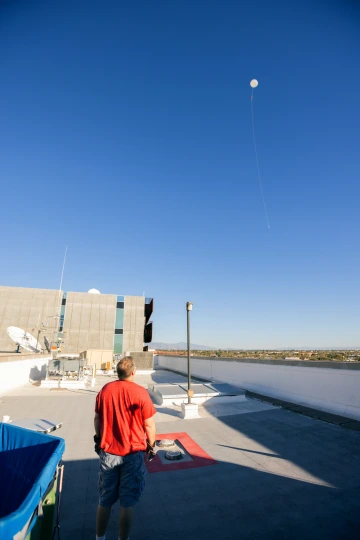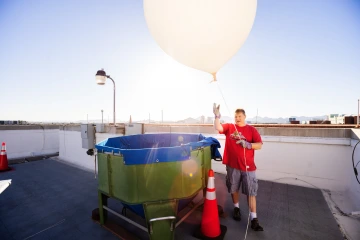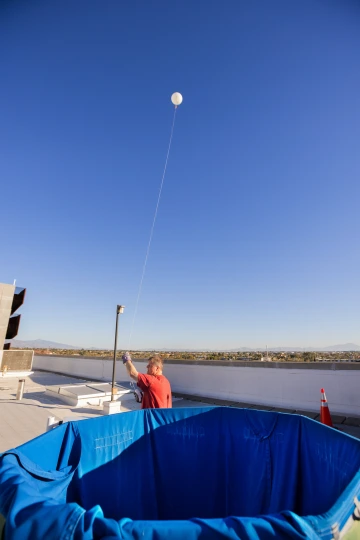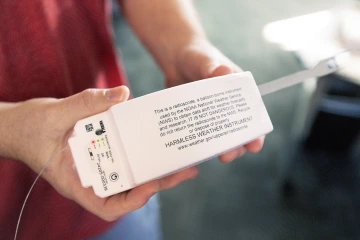Up and Away
Checking in with the National Weather Service meteorologists who help deliver the weather.

Meteorologist Chris Rasmussen releases a balloon at an afternoon launch. The balloon will expand to its peak diameter of 30 feet.
Chris Richards
Every day at 4 a.m. and 4 p.m., a meteorologist from the National Weather Service walks up a narrow staircase to the roof of a building at the edge of the University of Arizona campus and releases a balloon into the sky. Attached to the end of the balloon is a length of string about 100 feet long, and attached to that string is a small transmitting device called a radiosonde, which measures four key weather metrics: temperature, relative humidity, wind and air pressure. It looks like a little white mouse with metal whiskers.

Chris Richards
When the balloon gets high enough, it pops, and the radiosonde comes floating back to Earth under a small orange parachute. “You don’t want to have somebody walking their dog and all of a sudden get hit by [something] coming down at terminal velocity,” says meteorologist Chris Rasmussen ’96. “Yeah, that’s bad. That’s bad.”
But should you be walking your dog and see a radiosonde come drifting in from out of the sky, you would know it in part by the marking on its back: HARMLESS WEATHER INSTRUMENT. By the time the balloon pops, it has been traveling for approximately two hours, reached a height nearly three times most commercial plane flights and expanded to a diameter of nearly 30 feet, all the while relaying to scientists on the ground the data that makes up what most of us call “the weather.”

Chris Richards
This is done on approximately 92 rooftops across the United States and affiliated territories per day, at a cost of $4 per citizen per year. (The Tucson NWS office is one of several colocated with universities in an effort to promote research and collaboration.) Ninety-two balloons going up at roughly the same time, 92 strings and parachutes, 92 instances of a person briefly leaving their cubicle and slipping into a different kind of time.
“It kind of goes back to your own childhood,” Rasmussen says. “You’re filling up a balloon and you’re letting it go and you’re watching it go up. That level of excitement is actually kind of what you get by doing the balloon release every day. It’s a very simple process.”
Time and technological advances have made the process easier, Rasmussen says, but it still retains the patient, analog quality of old-school science: The string used is not any mysterious kind of string, and when Rasmussen lays it out on the rooftop, he does so in an M shape, so it doesn’t get wrapped around his feet. (He also has to look both ways for plane traffic to and from Davis-Monthan Air Force Base.)

The radiosonde, which transmits the balloon’s readings back to Earth
Chris Richards
Anyone who has lived anywhere for any amount of time will agree that the weather is not predictable. What is predictable, at least for now, is a twice-daily ritual of offering a strange piece of machinery to the sky in an effort to understand our condition just a little bit better.
“I’m usually just kind of a go-with-the-flow kind of guy,” Rasmussen says. “Except for a balloon release. You do it the same way every time, and you won’t make a mistake.” Right. Leave the going-with-the-flow to the balloon, which is now leaving the ground and growing smaller by the second, a white dot in an embrace of blue.
